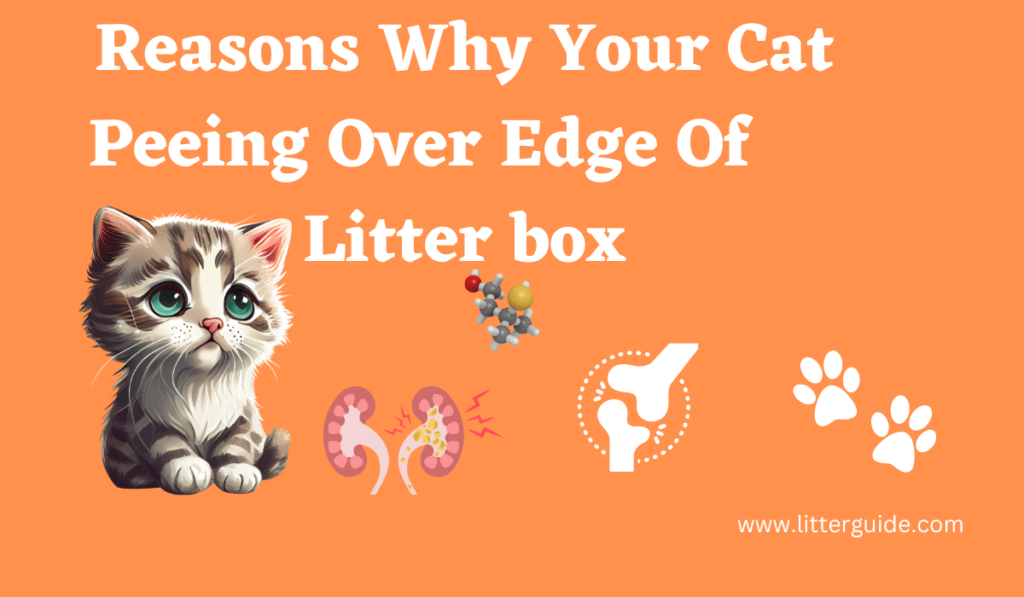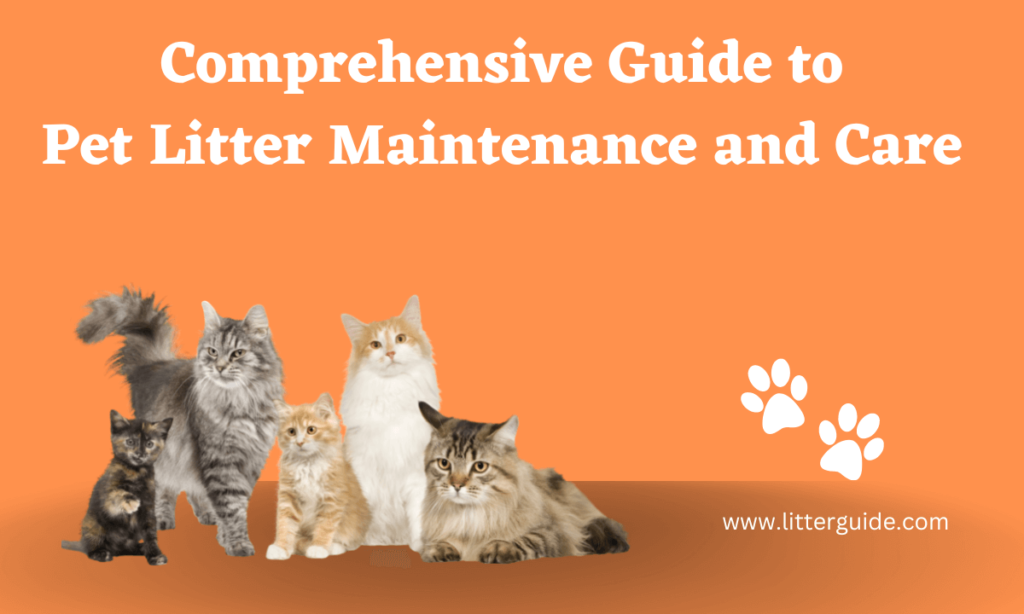Picture this: you enter your home after a long day at work, hoping to unwind and relax with your Cat. But alas, there it is again—your cat’s peculiar habit of peeing over the edge of the litter box. It can be frustrating and perplexing, but fear not! In this blog post, we’ll dive into the depths of this unusual behavior, uncovering nine possible reasons why your cat insists on turning its bathroom routine into a high-stakes game of “Pee the Edge.” By understanding the underlying causes, we can find solutions to help your cat get back on track.
1: Medical Factors
Urinary tract infections
Urinary tract infections (UTIs) are a common medical condition that can affect cats, and they can play a significant role in causing cats to pee over the edge of the litter box. UTIs occur when bacteria enter the urinary tract, leading to inflammation and discomfort. The infection can affect the bladder, urethra, or other parts of the urinary system.
UTIs can cause cats to experience pain or a burning sensation while urinating, leading them to associate the litter box with discomfort.
The inflammation and irritation caused by UTIs can create a sense of urgency in cats, making them urinate more frequently and potentially outside the litter box.
Cats with UTIs may exhibit signs of discomfort, such as frequent licking of the genital area, excessive meowing, or straining to urinate.
Bladder Stones
The presence of bladder stones can be another underlying cause of cats peeing over the edge of the litter box. Bladder stones are mineral accumulations that form in the bladder, causing discomfort and altering the cat’s normal elimination routine.
Bladder stones can irritate the bladder lining, leading to increased urgency and frequency of urination.
The presence of bladder stones can create a blockage or obstruction, making it difficult for cats to fully empty their bladders, resulting in more frequent urination.
Cats with bladder stones may experience pain or discomfort while urinating, causing them to associate the litter box with negative sensations.
Other Medical Issues
Various other medical conditions can contribute to cats peeing over the edge of the litter box. Here are a few examples:
Diabetes:
Diabetes mellitus, a metabolic disorder characterized by elevated blood sugar levels, can lead to increased urine production and excessive thirst in cats. These factors can result in cats peeing over the edge of the litter box.
Kidney Disease:
Chronic kidney disease can affect a cat’s ability to concentrate urine and regulate hydration levels. As a result, cats with kidney disease may urinate more frequently and in larger amounts, potentially leading to accidents outside the litter box.
Arthritis:
Cats suffering from arthritis may experience joint pain and stiffness, making it uncomfortable for them to climb into or position themselves within the litter box. This discomfort can contribute to litter box avoidance behavior.
Arthritis can cause mobility issues, making it difficult for cats to access or use the litter box comfortably
Understanding these medical factors and their impact on litter box behavior is crucial in identifying potential underlying health issues. If you suspect any medical conditions as the cause of your cat’s inappropriate elimination, it’s essential to consult a veterinarian for proper diagnosis and treatment.
2: Litter Box Size and Accessibility
Importance of Litter Box Size
The size of the litter box is an essential factor in ensuring cats have a comfortable and appropriate elimination experience. A litter box that is too small can pose challenges and may contribute to cats peeing over the edge of the box.
In a natural setting, cats have the instinct to dig and bury their waste. A small litter box restricts their ability to perform these behaviors comfortably, leading to frustration and potentially inappropriate elimination outside the box.
Accessibility Challenges
The accessibility of the litter box is another crucial aspect to consider when addressing cats peeing over the edge. Difficult entry or high-sided litter boxes can make it challenging for cats to enter and exit the box comfortably.
Cats prefer easy access to the litter box to maintain a sense of safety and security during elimination. If the entryway is too high or narrow, it can create a barrier for some cats, leading to avoidance or accidents.
Older cats or those with mobility issues, such as arthritis, may struggle with litter boxes that require jumping or climbing. This can result in decreased litter box usage and potential accidents.
It is important to select a litter box size and design that suits your cat’s needs and preferences. Providing a spacious and easily accessible litter box can encourage proper elimination behavior and reduce the likelihood of cats peeing over the edge.
3: Considerations for Choosing the Right Litter Box:
Size:
Opt for a litter box that allows your cat to comfortably move, turn around, and dig without feeling constrained.
Entryway:
Ensure the entry is low enough for easy access, especially for kittens, older cats, or cats with physical limitations.
Sides:
Choose a litter box with appropriate side height that prevents litter spillage while still allowing easy entry and exit for your cat.
By understanding the importance of litter box size and accessibility, you can create a more inviting and user-friendly environment for your cat. This, in turn, can help address the issue of cats peeing over the edge of the litter box and promote proper litter box usage.
4: Litter Box Placement and Privacy
The placement of the litter box plays a significant role in determining a cat’s comfort and preference when it comes to elimination. Cats are naturally cautious animals and prefer a safe and secure environment for their litter box activities. Therefore, the location of the litter box can greatly influence their behavior.
Quiet and secluded area:
Place the litter box in a calm and quiet part of the house, away from loud noises or disturbances. This provides a peaceful environment where your cat can feel comfortable while eliminating.
Accessible but private
Ensure the litter box is easily accessible for your cat, but also provide a degree of privacy. Avoid placing it in open areas or near household appliances that may startle or disturb your cat during their litter box routine.
Lack of Privacy
Cats are inherently private animals, and a lack of privacy in the litter box area can lead to cats seeking alternative elimination spots, including peeing over the edge of the litter box. It is important to understand and cater to their need for privacy to maintain proper litter box habits.
When cats feel exposed or vulnerable during elimination, they may feel the need to find a more secluded and secure spot to maintain their privacy.
A lack of privacy can also lead to increased stress and anxiety in cats, which can further contribute to inappropriate elimination behaviors.
Providing a private and serene environment for your cat’s litter box can help alleviate their anxiety and promote consistent litter box usage.
5: Litter Box Cleanliness and Maintenance
The cleanliness of the litter box is vital for your cat’s hygiene and overall litter box usage. Cats are known for their cleanliness and prefer a clean and odor-free environment. Therefore, maintaining a clean litter box is essential to ensure your cat’s comfort and encourage proper elimination habits.
Cats have a highly developed sense of smell. They can be deterred from using a litter box if it is dirty or has a strong odor.
A dirty litter box can create a breeding ground for bacteria, which can lead to urinary tract infections and other health issues in cats.
Understanding the significance of a clean litter box and implementing proper cleaning practices is crucial for your cat’s well-being.
6: Stress and Anxiety
Stressors in a cat’s environment can significantly impact their litter box habits. Identify common stress triggers and understand how they can lead to inappropriate elimination behavior.
Major changes like moving houses or introducing new pets can induce stress and anxiety in cats, resulting in litter box issues. Discover strategies to minimize stress and create a calm environment for your Cat.
7: Multi-Cat Dynamics and Litter Box Sharing
Conflicts among multiple cats can affect litter box usage. Learn about the territorial dynamics that can lead to cats peeing over the edge and find ways to manage multi-cat litter box challenges.
Cats may resort to peeing over the edge of the litter box as a means of asserting dominance. Understand the relationship between territorial marking and litter box behavior and explore methods to address these issues.
8: Litter Substrate Preferences
Some cats have specific preferences for litter substrate texture, and a mismatch in texture can result in litter box aversion. Gain insights into different textures and select the right litter based on your cat’s preferences.
Unsuitable Litter Types
Using the wrong type of litter can discourage cats from using the litter box. Discover the various litter options available and find the perfect match for your cat’s needs.
9: Behavioral Issues
Anxiety and Fear
Anxiety or fear can be underlying factors contributing to a cat’s avoidance of the litter box. Learn how to identify and address anxiety-related issues to promote appropriate litter box usage.
Negative Associations
Past negative experiences associated with the litter box can create a lasting impact on a cat’s behavior. Explore behavior modification techniques to retrain litter box habits and overcome negative associations.
Behavioral Issues
cats peeing over the edge of the litter box can be a frustrating issue, but it is not without solutions. By understanding the above nine most common reasons behind this behavior, from medical factors to environmental triggers and behavioral issues, cat owners can take proactive steps to resolve the problem. Remember, maintaining a clean and suitable litter box environment, addressing medical concerns, reducing stress, and providing the right litter substrate are essential in encouraging proper litter box usage. With patience, understanding, and the insights shared in this blog post, you can help your cat regain their litter box confidence and create a harmonious living environment for both you and your feline companion..



